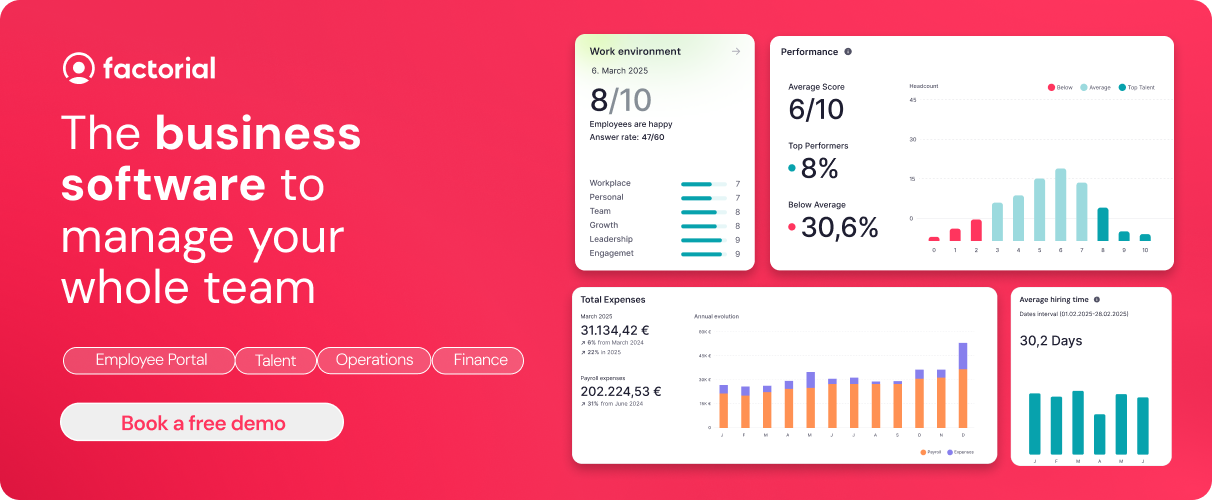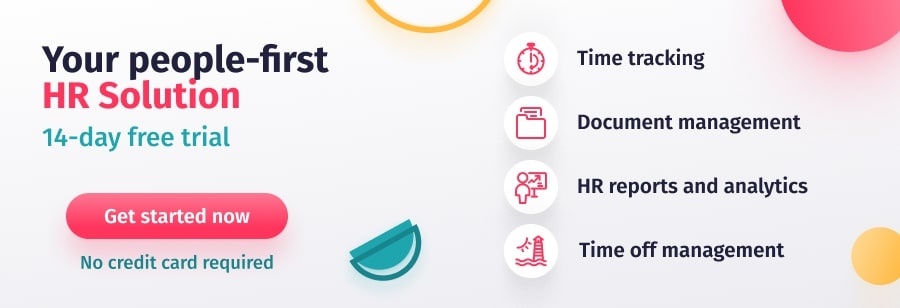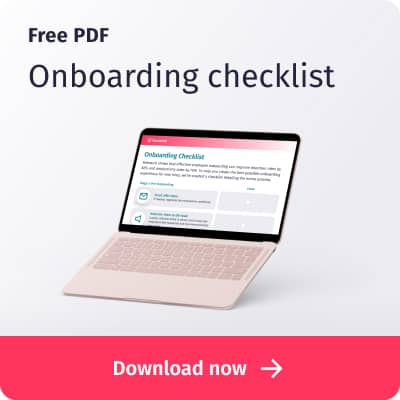One of the best ways to improve your new employee onboarding experience is by implementing a buddy system. A buddy program can help new employees fit in and speed up their time to productivity. In fact, according to a study conducted at Microsoft, new hires with buddies were 23% more satisfied with their overall onboarding experience, and 73% indicated that having a buddy system at work helped them to become more productive in their role.
In today’s in-depth guide we are going to cover every step of creating a buddy system for your organization. We’ll cover questions like “What is the buddy system?” and “What is an onboarding buddy?” We will share everything you need to know so that you can implement your own buddy system for new hires, including a handy checklist for each stage of the onboarding process.
- What Is the Buddy System?
- How Does the Buddy System Work?
- Why Is the Buddy System a Good Idea?
- How to Implement a Buddy System at Work
- Buddy System at Work Checklist
- Onboarding Buddy Program Examples
- Learn More ABout Onboarding Employees with Factorial ✅
What Is the Buddy System?
The buddy system is one part of a comprehensive onboarding process.
Employee onboarding is a new hire’s introduction to your company. It’s a vital stage for introducing a new hire to your organization’s structure, culture, vision, mission, and values. When done correctly, the employee onboarding process can help new hires become integrated, motivated, and productive members of your team. This might be through digital onboarding, remote onboarding or a more traditional office-based onboarding process.
One way to ensure your onboarding program is as effective as possible is to incorporate a buddy system in your company.
Buddy system meaning: A knowledge-sharing method used to onboard new employees. Each new employee is paired up with a more experienced member of staff who guides and supports them throughout their first few weeks or months on the job.
How Does the Buddy System Work?
With the buddy system, a member of staff is assigned to a new employee on their first day at the office. The role of this buddy is to welcome the new hire, help them navigate their new surroundings, and answer any questions they may have.
For example, a buddy might give the new hire a tour of the office, introduce them to their new colleagues, or take them out for lunch. They can also help them understand company policies, and give them an overview of the organization’s culture, mission, vision and values.
All this helps the new employee feel more comfortable so that they can achieve a sense of belonging and integrate seamlessly into their new role. They also have someone to talk to if they have any questions that may not have been addressed by HR. This can be especially useful if a new starter is shy or doesn’t feel comfortable raising questions with their new boss.
Why Is the Buddy System a Good Idea?
Benefits of a peer buddy system include:
- Improves your onboarding process. An onboarding buddy can help new recruits feel welcomed and speed up the process of learning your internal systems and processes.
- Increases employee satisfaction. Pairing a new hire with an onboarding buddy is a great way to provide them with the support and training they need to handle their new role. This extra guidance reduces employee frustration and improves overall job satisfaction.
- Enhances the employee experience. With an onboarding buddy program, you can show new hires that you care about their experience at your company and that you want them to feel comfortable and settled as soon as possible.
- Boosts productivity. The sooner your new hires understand your culture and their role, the sooner they can become productive employees. Plus, if new hires feel welcomed, they are more likely to form friendships with their colleagues, helping them communicate and collaborate with their new teammates.
- Raises retention. If you provide a positive employee experience from day one, your new hires are far more likely to decide to stay at your company, increasing retention and reducing high turnover costs.
- Improved learning and development. A buddy reinforces the level of training that an employee receives from their first day at your company. And the more insights they get from their buddy, the faster they will develop new skills in your organization.
- Faster integration into your culture. The best way for a new hire to understand your company culture is to live it. A buddy helps new hires interact with different levels of your company so that they can become a part of your corporate culture much faster.
- The buddy system is also a great opportunity for you to identify emerging leaders and mentors amongst your existing staff.
How to Implement a Buddy System at Work
Creating a buddy system for new hires is easy to implement and cost-effective. The key to creating an effective buddy system is choosing the right buddies, designing the right guidelines, and using the right tools to manage your program. This means choosing willing buddies with the right experience, creating an informative buddy guide, and setting clear expectations.
Select the Right Buddies
One of the most important aspects of creating a buddy system at work is choosing the right employees to be your buddies. Your buddies should ideally have been working at your organization for some time already. They need to have the right experience and understand your internal structure, processes and systems, as well as your culture, values and mission. That way, your buddies will have a fountain of valuable knowledge to pass onto your new recruits.
Your buddies need to be friendly and approachable. They need to have a positive attitude and good communication skills. They also need to be willing. Never force somebody to be paired up as a buddy, as you may end up creating a negative first impression.
Here are a few other qualities and characteristics to look for in your buddies:
- Respected team member
- Fully assimilated within the company culture
- Strong and experienced performer
- Functional and organizational awareness
- Patience and kindness, as well as a desire to guide others
- Committed to involving new hires in social activities such as team lunches and external gatherings
- Skilled listener that will provide encouragement
- Actively seeking opportunities to learn and develop leadership and mentoring skills
When you ask potential buddies to volunteer, be clear about your expectations.
Take control with intuitive Business Management Software.👇

Create an Onboarding Buddy Guide
Once you’ve found a good group of buddies, you need to create a guide to help them understand what their new mentorship role will entail. Make sure you explain how the buddy program will work, what the purpose of the initiative is, and any ground rules and guidelines. You also need to be clear about what their role is so that there is accountability.
Consider the following when you design your onboarding buddy program:
- Responsibilities: Which tasks will the buddy take responsibility for, and which will be managed by HR?
- Schedule: Will they be provided with an onboarding buddy checklist? (more on this below)
- Duration. How long will the buddy program last?
- Frequency. How often should they meet with their buddies, and for how long?
- Conversation starters: What should they talk about? (For example, the buddy’s own onboarding experience; unwritten rules of the organization; things the buddy wishes they had known when they started, etc.)
Want to see a sample? Check out NYU’s new employee onboarding buddy guidelines.
Manage Goals & Expectations
You need to make sure you establish clear goals and expectations so that your buddies know what you want them to do. The best way to do this is to create an onboarding buddy checklist. This checklist should cover everything from onboarding documents to introductions, office tours, processes, software, and anything else you think your new hires need to know.
The aim here is for your buddies to pass on as much information as possible so that your new recruits can become productive team members as quickly as possible. Make sure you clarify exactly what you expect your buddies to do to achieve this goal. Be clear about any support and resources you will offer your employees as part of your buddy system at work initiative.
You should also make sure you consider the goals and expectations you will set for your new hires. How proactive do you expect new recruits to be? Should they reach out to their buddies whenever they need to, or wait for a scheduled check-in? What if they aren’t happy with the buddy they have been paired with – can they reach out to HR for support?
Use a Digital Onboarding Platform to Manage Your Buddy System
Finally, you need to make sure you use the right tools to manage your buddy program as efficiently as possible. If you don’t already have one, it’s a good idea to implement an HR onboarding software solution to help your program run as smoothly as possible.
You can use a digital onboarding platform to:
- Schedule every task in your onboarding buddy program so that all areas are covered for each new recruit.
- Create reminders and prompts to help keep buddies and new hires on track with the program.
- Program regular check-ins so that your buddy can meet with their paired new hire on a regular basis. You can also schedule check-ins with your buddies to gather valuable feedback that can help you improve your program.
- Provide new hires with a full introduction to your company’s structure, internal policies, processes, systems, values and goals.
- Create valuable and engaging employee onboarding programs to help get your new hires up to speed and productive as soon as possible.
- Enhance your overall onboarding experience.
Buddy System at Work Checklist
The best way to ensure you design an effective buddy system that helps you integrate new hires is to create an onboarding buddy checklist. This will help you cover all areas of the onboarding process, including defining the role of your buddies and setting goals and expectations.
This checklist should be an extension of your general onboarding checklist (if you don’t already have one of these, check out Factorial’s onboarding checklist which helps you keep track of every stage of the onboarding process).
The following is an example of what you should include in your onboarding buddy program at work checklist. This checklist covers every stage of the preboarding and onboarding process.
Preboarding Tasks
- Speak to managers to find out anything specific you need to cover with the new hire during onboarding.
- Share onboarding buddy checklist and program materials with the assigned buddy so they can prepare for the new hire’s first day. Encourage them to review your buddy guidelines and reach out if they have any questions.
- Schedule the first meeting with the new hire on their first day so you can introduce them to their buddy.
Preboarding is also a perfect opportunity to complete as many onboarding documents in advance as possible so that your new employee can focus on getting to know their buddy on their first day. For example, if you work in manufacturing, you can share information about Good Manufacturing Practices in advance so that new hires can begin familiarizing themselves with materials and equipment.
You should also make sure you clarify the difference between onboarding vs. orientation so that your new hire knows what to expect when they arrive at the office on their first day.
First Day
- Welcome a new employee as soon as they arrive at the office and introduce them to their buddy
- Remind onboarding buddy to check in with new hire regularly
- Encourage buddy to take the new hire on a tour of the office to introduce them to their new colleagues
- Conduct creative new employee onboarding activities
- Show new hire their desk/workspace
- Help with answering questions or queries or offering support when needed
During First Week
- Introduce the employee to other departments
- Help the new hire with ordering equipment and other office supplies
- Explain employee role and expectations
- Complete any onboarding buddy tasks designed for new hire’s first week (icebreakers, social activities such as lunch or coffee with the team, etc.)
- Share employee handbook and explain all policies, benefits, perks such as wellness programs, etc.
- Set up new employee with software accounts, email, internal communication and collaboration tools, etc.
- Explain use of refrigerator, oven, microwave, break area, etc.
- Review and clarify all appropriate safety procedures
- Schedule a 15-minute meeting at the end of the first week to check-in
- Review what has already been covered in the checklist, and determine additional questions
- Remind new hire you are there to help with answering questions or queries or offering support when needed.
Following Months
- Conduct weekly check-in meetings with the new employee to see how they are settling in.
- Meet with buddy to see if they have any feedback or need any additional support.
- Track your onboarding metrics to evaluate the onboarding experience you are providing new hires
- Use surveys to evaluate your buddy system and make adjustments where necessary.
Onboarding Buddy Program Examples
Finally, let’s finish by taking a look at a couple of examples of a successful buddy system to help inspire you to create your own program. Think about how these ideas might work in your organization.
Microsoft’s Buddy Program
Microsoft is constantly researching and adjusting its procedures in order to offer the best employee experience to both new and existing employees. They do this because they understand the impact employee satisfaction has on productivity and overall success. The company also understands the pivotal role an onboarding buddy program can have on successful onboarding experiences.
With this in mind, Microsoft designed a pilot buddy system at work program and launched it across the entire organization.
The company identified three key findings:
- Onboarding buddies provide a level of context that employees cannot get from an employee handbook.
- Meeting onboarding buddies frequently boosts productivity.
- Employees with onboarding buddies report greater satisfaction.
Microsoft has since expanded its new hire onboarding buddy program by creating an internal site for hiring managers to match new hires with current employees to buddy up.
According to the company’s general manager for employee career and development:
“Employees who have effective onboarding buddies are more satisfied with onboarding resources, more easily find the right contact for their questions, and feel that their buddies help them expand their networks and become more productive in their new role.”
Buffer’s Buddy Program
Buffer, a remote-first company, spent a lot of time perfecting its onboarding program. The aim was to create an onboarding process that promotes diversity, offers psychological safety, and enables new hires to enjoy the same benefits as other full-time employees.
As part of the company’s updated onboarding program, it has created a unique buddy system. This system is founded on the principles of communication and technology. What’s more, instead of assigning one buddy to each new hire, Buffer employs a three-buddy system with defined roles to help new hires:
- Leader buddy: a team member with lots of experience, such as a manager
- Role buddy: a peer who understands the new hire’s role
- Culture buddy: a seasoned employee who helps new hires learn about the company’s vision, culture, and strategy
In fact, Buffer’s buddy system has been such a success that even Google has adopted a similar program!
What will your buddy system look like? How can you improve your own onboarding experience?



